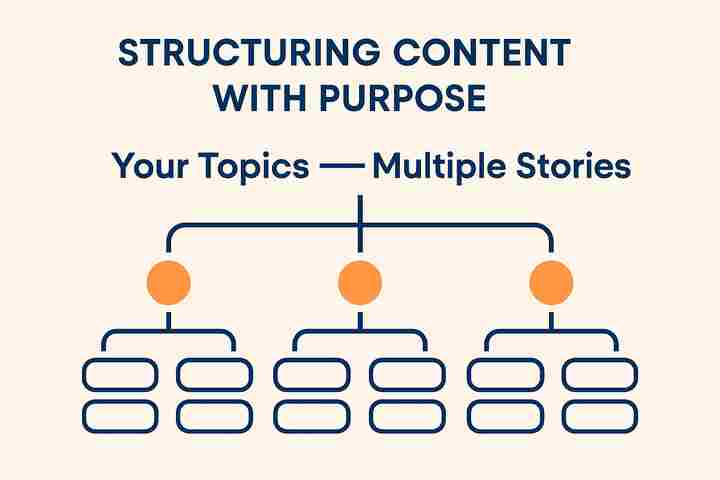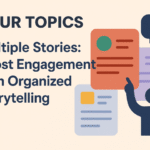Content organization is critical in the modern digital era, where there are a lot of things going on. “Your Topics | Multiple Stories” is a method of content strategy that is quite clever. Being a creator, it is possible to assemble articles according to certain topics, making it more approachable for the readers who are eager to see all the articles connected to them. The said approach does not only increase the content visibility in the search engine results page, as it also provides a better user experience, and in the end, it earns the attention of the users who are under the same content category.
You can be a blogger, a business owner, or a media platform, but storytelling in an organized manner is the only way to build the trust of your audience and generate traffic. Just center your efforts on creating and embracing an organizing principle, and the subsequent lucid content will touch the heart of your audience and encourage them to follow the plot.
This paper explains how “Your Topics | Multiple Stories” works in terms of thematic content organization, why it is important, and who can gain from it.
What Is Meant by ‘Your Topics | Multiple Stories’?
Structuring Content with Purpose

This is actually an explanation of “Your Topics | Multiple Stories,” being a plan to put content into groups or categories so that the topics are clear. Each story will have more to tell with them as they attract each other to the same or similar topic.
The point here is that this model is not just a question of attractiveness, and having such a structure, it also becomes a logic not only for the search engines but also for the readers. Creating blogs that are not related is not logical; creators should come up with a topic they would like to center their blogs around so that they can bundle them and create a content journey.
Benefits of effective organization:
- Assists readers to understand and follow the topic from the very beginning to the end with ease and an encouraging ability for the reader to navigate to other interrelated topics by the use of a topic-based interlinking method
- Empowers users to explore more content with extra guidance
- This approach results in lower bounce rates and longer session durations.
- Enables content planning and management to be really easy for publishers
One possible example of implementing subjects like “Artificial Intelligence,” “Gadgets,” and “Cybersecurity” in a technology blog could be to arrange the main page into these topics. Each category should consist of various main stories (or news) servings, including detailed descriptions of subtopics that are all set out in a way that readers can avail themselves of.
User Experience: Ensuring Users Are Always Interested
Digital publishers consider user experience (UX) first and foremost. The more convenient it is for users to discover and follow the content they are interested in, the longer they will be present on your website, and the higher the chances of returning. Your Topics | Multiple Stories is an example of instances where the ease of navigation is self-explanatory.
Main UX Boosts:
- Climax: Stories within a topic can seamlessly connect, ensuring the reader maintains their flow of thought throughout the session.
- Informational revelation: The systematic arrangement of articles brings the reader into contact with those he/she might not have looked for and thus generates additional page views.
- Capacity reduction of the brain: The time it takes for a user to reach a related post is greatly reduced as the endless scroll and the search bar are no longer essential.
- Adaptable to mobile: Bundled stories, available under topics, constitute a card-designed interface that works well on mobile devices. Perfect for user experience
Medium, BBC, and Netflix are companies that make use of such concepts. For instance, Medium groups stories into publications and places them under specific tags at the top. Netflix arranges content based on its type and selected keywords. These familiar models offer the audience the benefit of understanding the new digital language quickly.
Content Creator Benefits: Efficiency and SEO
The approach called “Your Topics | Multiple Stories” is not only readable by the audience but also is the kind that facilitates the creator as well. The structured content, be it on a personal blog or a multi-author platform, will help project managers in the matter of workflows, become more findable, and digest any changes easily.
Here’s the way content creators will benefit
1. Better SEO by way of Topic Clusters
The search engines do appreciate the well-structured content, which will be a huge advantage for you. The idea of wrapping multiple stories around a certain topic is the key to the topic as an entity or identifying the topic cluster. So, it implies that your website is not only deep but also has the most special information resulting in an SEO boost.
2. Simpler Content Planning
You can even simplify the schedule research process through this method. Instead of thinking of insignificant ideas, you can easily map out your contents in sets in the instantly recognizable order that the best topics have. One of the best examples is the category “Mental Health,” which gives you the option to tell stories like
- “How to Manage Anxiety Naturally”
- “The Science Behind Meditation”
- “Nutrition’s Role in Mental Wellness”
3. Efficient Content Updates
If there is a need for fact accuracy or data massage, the easiest way is to pinpoint and adjust one section at a time. You can then just retrieve and subsequently edit many relevant post units easily, which are still present. Instead of looking for pieces individually, you can always rely on your master file to know where everything is.
4. Enhanced Teamwork
Utilizing it, team members can be divided into different thematic roles. Additionally, this situation proves to be interesting and serves as a great place for brainstorming. For instance, a writer can be like “Fitness Tips,” and another one is “Healthy Recipes,” both of them being under the umbrella “Wellness.”
5. Getting Profit from User Participation
By making a user stay more time on your page and come back for more visits, you will earn more money through clicks, like a partner converting this person to a regular customer or a user to a subscriber. Besides, among the greater number of such interactions, there are many more legitimate users.
Across Niches and Platforms
The “Your Topics | Multiple Stories” strategy is not just multi-touch, but the “Your Topics | Multiple Stories” strategy is not only multi-touch but is rather versatile. Different business areas and content forms can utilize this strategy:
1. Blogs and Content Marketing
Best Techy can segment blogs, for example, by category like this:
- Travel: “Top 10 Destinations,” “Budget Travel Hacks”
- Food: “Vegan Recipes,” “Meal Prep Ideas”
- Finance: “Budgeting Tips,” “Passive Income Ideas”
2. News and Editorial Platforms
For instance, the largest division of a news website, the main political group, would be mostly involved with:
- Politics: “Election 2025 Coverage”
- Technology: “AI and Automation”
- Health: “COVID-19 Updates,” “Mental Health Awareness”
3. E-learning and Educational sites.
Teachers and educational material developers can build comprehensive units of learning materials on a specific topic:
- Math: “Algebra Basics,” “Trigonometry Explained”
- History: “World War II,” “Ancient Civilizations”
- Science: “Biology 101,” “Physics in Everyday Life”
4. E-commerce and Product Guides
Furthermore, it would drive sales much higher and thus give a big UX lift if online stores made a buyer’s guide, something like
- Electronics: “Top Smartphones,” “Smart Home Devices“
- Fashion: “Summer Wardrobe Essentials,” “Formalwear Guide”
5. Social Media Campaigns
Both Instagram and YouTube would benefit from implementing content highlights or playlists that are organized by topic, following the “Your Topics | Multiple Stories” workflow.
How a Health Blog Uses “Your Topics | Multiple Stories”
Assuming you are the owner of a health and wellness blog. Here is an
Main Topic: Natural Health Tips
- Story 1: “TheTop 10 Natural Remedies for Headaches “
- Story 2: “How to Sleep Better Without Pills”
- Story 3: “Benefits of Herbal Teas for Immunity”
Topic: Fitness for Beginners
- Story 1: “30-Day Home Workout Challenge”
- Story 2: “Beginner’s Guide to Yoga”
- Story 3: “Best Bodyweight Exercises for Busy People”
Main Topic: Nutrition & Diet
- Story 1: “Superfoods That Boost Energy”
- Story 2: “Meal Planning for Weight Loss”
- Story 3: “Understanding Gut Health and Probiotics”
The reader per topic is the starting point from where he or she can consume further content if they wish. With this lighthouse approach to content, creators can easily multiply engagement opportunities and, at the same time, not ask for anything from the audience by being helpful.
Tips to Implement “Your Topics | Multiple Stories” Effectively
- Use Clear Labels: Topic titles should be both user-friendly and SEO-minded at the same time.
- Construct Navigation Hubs: Establish a homepage or a kind of sidebar for each theme.
- Link Inside your Page: Make sure each story within a category has links to and from others of the same group.
- Maintain Consistent Formatting: Stay loyal to one and the same style throughout all the stories belonging to the same grouping.
- Do Topic-Based Analytics: Employ a handy instrument such as Google Analytics in order to see which of your topics lead the most team to a page.
Conclusion
Posts published just regularly without any order are out of date now. In today’s era of a content glut, those who will survive will make use of top-level organization, focus, and awareness only. The “Your Topics | Multiple Stories” strategy allows you to produce content that will not only be read in passing but also remembered, shared, and re-enjoyed.
Maybe you are a blogger and your goal is to increase the traffic to your website, or you are a teacher who wishes to manage the content more easily, or even a company that is trying to amplify its topical authority. If so, this method is your perfect tool for sustainable growth. It’s not about publishing more but about being wiser with your content publishing strategy.
Your Questions Answered
1: What is “Your Topics | Multiple Stories”?
It is a content strategy where different articles all centered around a single theme or topic are assembled together to achieve better SEO, organization, and user engagement.
2: Can smaller websites utilize this strategy too?
Yes, this strategy is not only for large websites; anyone who operates their own blog can implement it to better organize their content and make it more discoverable.
3: Will it contribute to SEO performance?
Yup! Topic clusters are very beneficial for internal linking, and they also send a message of authority to the search engines.
4: What are the platforms that can do it?
WordPress, Medium, Wix, and most CMS platforms allow for category- and tag-based grouping.
5: Would it be possible to use this method for video or podcast content?
Yes, you can. Make the videos or podcasts a playlist or a series of topics.















